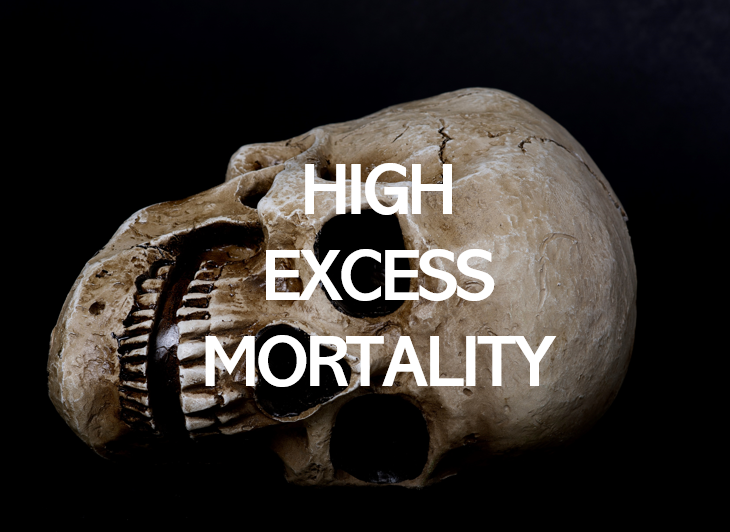Insurance industry coalition forms non-profit to study baffling excess mortality

A coalition of insurance industry and healthcare leaders have formed a non-profit organization to help global insurers screen, test, and triage members to combat the baffling rise in excess mortality.
Members of the group, called The Insurance Collaboration to Save Lives, say they were increasingly concerned about excess mortality and morbidity trends that even three years after the start of the COVID-19 pandemic, have not returned to pre-pandemic levels.
Excess mortality, defined as more deaths than normally expected, rose during the pandemic with estimates of 16.8 to 28.1 million worldwide excess deaths from all causes. But as COVID-19-related deaths decreased through 2022, excess mortality continued to persist in many countries.
“It was the fire insurance industry that got together and created fire departments...We need some fire brigades, because things are on fire.”Josh Stirling, former equity analyst and co-founder of the Collaboration
Statistics show the mortality gap increased the number of U.S. deaths by 34.8% in 2021, resulting in 892,491 excess deaths that year. When controlling for population size, the annual number of excess deaths is up 84.9% between 2019 and 2021. In other words, the number of excess deaths each year almost doubled, according to the California Center for Population Research at UCLA.
With excess morbidity comes excess losses for insurers that could be significantly quelled with digital screening and triage of policyholders.
Josh Stirling, a former equity analyst and co-founder of the Collaboration, estimates proactive screening and testing could bring insurers a 50x to 100x return from the mortality savings. More important, though he said, the health screening, targeted blood testing, and intelligent use of data would save lives.
“We think insurers can positively impact the health of a large proportion of members they test and will realize a hockey-stick return from the mortality savings,” he said.
Stirling compared the Insurance Collaboration to Save Lives to the Red Cross, Underwriters Laboratory, or the Institute for Highway Safety, independent or government organizations that brought about reforms in health care, regulation, building codes, and automotive safety.
“It was the fire insurance industry that got together and created fire departments,” he said. “We should be doing the same thing here. We need some fire brigades, because things are on fire.”
Insurance industry problems may be ahead
Stirling believes there is a small window of opportunity for insurers to get ahead of the excess mortality problem before it becomes a major financial problem for the insurance industry. The Collaboration is seeking support and working capital to eventually roll out the screening processes nationwide, and then worldwide.
Assuming $200,000 average life policies and a $200 cost of screening, the savings will cover the costs if as few as 0.1%, or 1 in 1,000, lives are saved.
“So what we're saying is ‘let's pull together a bunch of technologies that detects problems’ and let's try to do it on an internet timeframe, or a startup timeframe, or a public health emergency timeframe, as opposed to an insurance industry timeframe, which is just naturally much more long term in nature,” he said.
Insurance industry support needed
Stirling said the Collaboration, with insurance industry support, could save 1 million lives in as few as five years. One million lives, he said, is just 1.5% of global mortality each year, and 15% of global excess deaths in 2022.
“If you’re spending like $5,000 a year for a life insurance policy, it’s not crazy to spend a $100 or $200 every year or every other year for screening,” he said. “They should be happy to make that investment to improve the quality of life of their members. Even if you look at it from a marketing point of view, it’s probably a worthwhile thing to do.”
Stirling hopes to have a pilot program in the market within three months. That timetable could be vastly improved with corporate sponsors.
“Even after COVID started to wane, it feels like there's problems with mortality, which I believe right now is a public health problem that can be addressed by insurance taking leadership,” he said. “I think longer term, there’s the possibility of litigation from this is going to be bigger than things like asbestos was for the insurance industry. So, let’s try to figure this out and solve this problem.”
Doug Bailey is a journalist and freelance writer who lives outside of Boston. He can be reached at [email protected].
© Entire contents copyright 2023 by InsuranceNewsNet.com Inc. All rights reserved. No part of this article may be reprinted without the expressed written consent from InsuranceNewsNet.com
Doug Bailey is a journalist and freelance writer who lives outside of Boston. He can be reached at [email protected].






Texas lawsuit: Lincoln Financial annuity fell far short of illustration promises
National health emergency declared over, ending use of some federal waivers
Advisor News
- Private equity, crypto and the risks retirees can’t ignore
- Will Trump accounts lead to a financial boon? Experts differ on impact
- Helping clients up the impact of their charitable giving with a DAF
- 3 tax planning strategies under One Big Beautiful Bill
- Gen X’s retirement readiness is threatened
More Advisor NewsAnnuity News
- LTC annuities and minimizing opportunity cost
- Venerable Announces Head of Flow Reinsurance
- 3 tax planning strategies under One Big Beautiful Bill
- MetLife Completes $10 Billion Variable Annuity Risk Transfer Transaction
- Gen X’s retirement readiness is threatened
More Annuity NewsHealth/Employee Benefits News
Life Insurance News
- Seritage Growth Properties Makes $20 Million Loan Prepayment
- AM Best Revises Outlooks to Negative for Kansas City Life Insurance Company; Downgrades Credit Ratings of Grange Life Insurance Company; Revises Issuer Credit Rating Outlook to Negative for Old American Insurance Company
- AM Best Affirms Credit Ratings of Bao Minh Insurance Corporation
- Prudential leads all life sellers as Q3 sales rise 3.2%, Wink reports
- AM Best Affirms Credit Ratings of Securian Financial Group, Inc. and Its Subsidiaries
More Life Insurance News